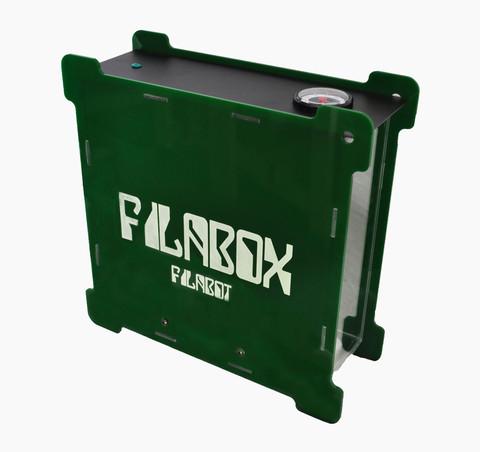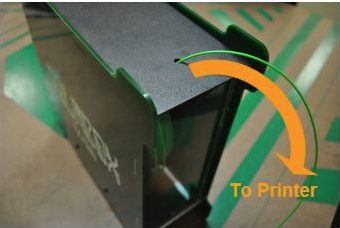The old saying about being left “high and dry” makes it sound as if that were a bad thing. When we’re talking about 3D printing filament, however, that is just what you want. The folks at Filabot understand and have responded by developing a box specifically designed to help you keep your filament in tip top condition so that your printing experience is headache free.
Team member Shayne Circe explained why they decided to put their minds to work on a project like this:
“One of the hardest things to combat, as most 3D printing enthusiasts or true 3D makers know, is moisture. The humidity in the air, whether you know it or not, is getting absorbed by your filament, and this can cause a handful of problems such as popping or sizzling during printing, bubbles, layer inconsistencies, layer adhesion, and weak prints. We noticed some of these things through all of the printing we do here and that is why we created the Filabox.”
This list of printing ailments that can be caused or exacerbated by moisture is enough to cause 3D print nightmares. If you live in Arizona or the Gobi Desert, you might not need to worry, but for the rest of us, it’s a daily battle.
The Filabox has a fully enclosed acrylic case, the seams have been sealed, and it is equipped with a rubber gasket seal on the lid; all in the name of keeping moisture out. In addition, a desiccant packet is inserted that draws unwanted moisture out of the internal air in the box and to ease your mind, there is also a humidity gauge mounted on the lid.
 Using it is simple. After placing the spooled filament into the box, you feed it out of the hole in the lid and directly into your 3D printer. When the spool is in the box, it rests on a set of plastic dowels that allow it to spin freely while being used for a print. And when you aren’t using it, you can plug the hole so that the desiccant isn’t simply filling up with all the moisture in the surrounding air.
Using it is simple. After placing the spooled filament into the box, you feed it out of the hole in the lid and directly into your 3D printer. When the spool is in the box, it rests on a set of plastic dowels that allow it to spin freely while being used for a print. And when you aren’t using it, you can plug the hole so that the desiccant isn’t simply filling up with all the moisture in the surrounding air.
Filabot doesn’t just manufacture the box, they also use it in each one of their in-house printing setups and have noticed as high as a 40% difference in humidity between the air inside and the air outside of the box on a humid summer day.
 This company, which began in 2012 (as a result of one student’s poor study habits during midterm exam week!), has continued to demonstrate the power of its ideas and its dedication to advancing the possibilities for 3D printing. With a firm commitment to recycling plastic to make filament, it only makes sense that their interests would expand to ensuring that the plastic for printing is in the best possible condition. Less moisture means less wasted plastic and more printing enjoyment, both of which are decidedly good.
This company, which began in 2012 (as a result of one student’s poor study habits during midterm exam week!), has continued to demonstrate the power of its ideas and its dedication to advancing the possibilities for 3D printing. With a firm commitment to recycling plastic to make filament, it only makes sense that their interests would expand to ensuring that the plastic for printing is in the best possible condition. Less moisture means less wasted plastic and more printing enjoyment, both of which are decidedly good.
Have you used Filabot’s Filabox? Let us know how it stacks up to other filament drying systems in the Filabox forum thread over at 3DPB.com.
Subscribe to Our Email Newsletter
Stay up-to-date on all the latest news from the 3D printing industry and receive information and offers from third party vendors.
You May Also Like
Precision at the Microscale: UK Researchers Advance Medical Devices with BMF’s 3D Printing Tech
University of Nottingham researchers are using Boston Micro Fabrication‘s (BMF) 3D printing technology to develop medical devices that improve compatibility with human tissue. Funded by a UK grant, this project...
3D Printing Webinar and Event Roundup: April 21, 2024
It’s another busy week of webinars and events, starting with Hannover Messe in Germany and continuing with Metalcasting Congress, Chinaplas, TechBlick’s Innovation Festival, and more. Stratasys continues its advanced training...
3D Printing Webinar and Event Roundup: March 17, 2024
It’s another busy week of webinars and events, including SALMED 2024 and AM Forum in Berlin. Stratasys continues its in-person training and is offering two webinars, ASTM is holding a...
3D Printed Micro Antenna is 15% Smaller and 6X Lighter
Horizon Microtechnologies has achieved success in creating a high-frequency D-Band horn antenna through micro 3D printing. However, this achievement did not rely solely on 3D printing; it involved a combination...






























